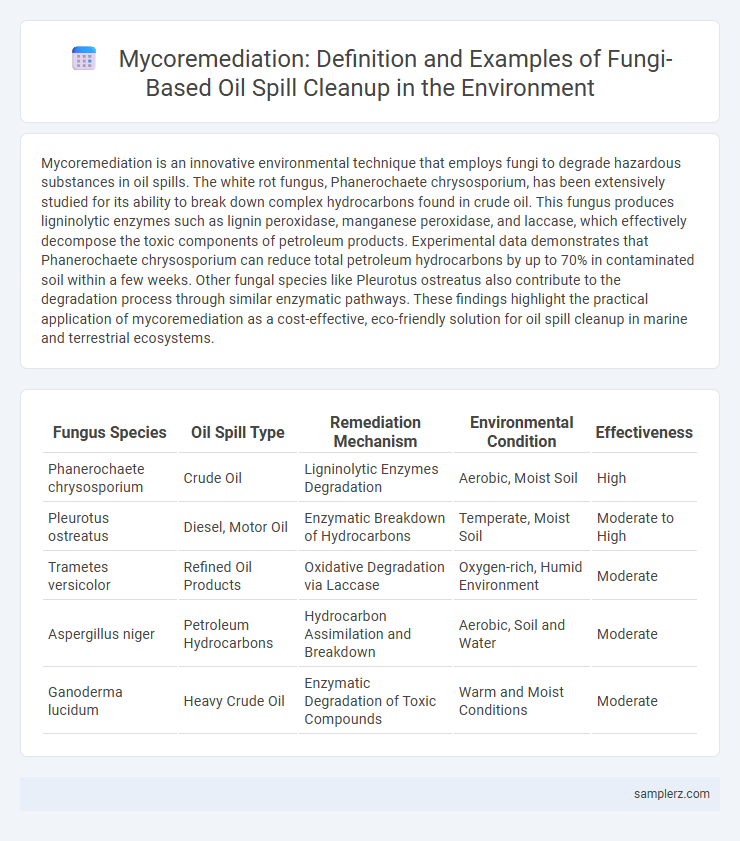Mycoremediation is an innovative environmental technique that employs fungi to degrade hazardous substances in oil spills. The white rot fungus, Phanerochaete chrysosporium, has been extensively studied for its ability to break down complex hydrocarbons found in crude oil. This fungus produces ligninolytic enzymes such as lignin peroxidase, manganese peroxidase, and laccase, which effectively decompose the toxic components of petroleum products. Experimental data demonstrates that Phanerochaete chrysosporium can reduce total petroleum hydrocarbons by up to 70% in contaminated soil within a few weeks. Other fungal species like Pleurotus ostreatus also contribute to the degradation process through similar enzymatic pathways. These findings highlight the practical application of mycoremediation as a cost-effective, eco-friendly solution for oil spill cleanup in marine and terrestrial ecosystems.
Table of Comparison
| Fungus Species | Oil Spill Type | Remediation Mechanism | Environmental Condition | Effectiveness |
|---|---|---|---|---|
| Phanerochaete chrysosporium | Crude Oil | Ligninolytic Enzymes Degradation | Aerobic, Moist Soil | High |
| Pleurotus ostreatus | Diesel, Motor Oil | Enzymatic Breakdown of Hydrocarbons | Temperate, Moist Soil | Moderate to High |
| Trametes versicolor | Refined Oil Products | Oxidative Degradation via Laccase | Oxygen-rich, Humid Environment | Moderate |
| Aspergillus niger | Petroleum Hydrocarbons | Hydrocarbon Assimilation and Breakdown | Aerobic, Soil and Water | Moderate |
| Ganoderma lucidum | Heavy Crude Oil | Enzymatic Degradation of Toxic Compounds | Warm and Moist Conditions | Moderate |
Harnessing Fungi: Mycoremediation Defined in Oil Spill Cleanup
Harnessing fungi for oil spill cleanup involves mycoremediation, a process where specific fungal species break down hydrocarbons into less toxic compounds. White-rot fungi, such as Phanerochaete chrysosporium, produce ligninolytic enzymes that degrade complex petroleum pollutants efficiently. This eco-friendly approach accelerates natural biodegradation, reducing long-term environmental damage in marine and terrestrial oil spill areas.
Successful Case Studies: Fungal Solutions for Crude Oil Contamination
Fungal species such as Pleurotus ostreatus and Phanerochaete chrysosporium have demonstrated significant success in the mycoremediation of crude oil-contaminated sites by breaking down complex hydrocarbons into less toxic compounds. Case studies from the Niger Delta and Gulf of Mexico reveal these fungi accelerate degradation rates, reducing environmental toxicity and restoring soil quality within months. This biological approach offers a cost-effective, eco-friendly alternative to conventional chemical and mechanical oil spill remediation techniques.
How Mycoremediation Breaks Down Petroleum Pollutants
Mycoremediation utilizes specific fungi species, such as white-rot fungi, to break down complex petroleum hydrocarbons in oil spills through enzymatic degradation. These fungi secrete ligninolytic enzymes like laccase and peroxidase, which oxidize and decompose toxic petroleum compounds into less harmful substances. This biological process accelerates the natural breakdown of pollutants, restoring contaminated ecosystems more efficiently than conventional methods.
Notable Fungi Species Used in Oil Spill Remediation
Notable fungi species used in mycoremediation of oil spills include white-rot fungi like Phanerochaete chrysosporium, known for its lignin-degrading enzymes that break down hydrocarbon pollutants. Pleurotus ostreatus, commonly called oyster mushroom, effectively degrades petroleum hydrocarbons through enzymatic pathways involving laccases and peroxidases. These fungi facilitate the biotransformation of complex oil components into less toxic substances, making them key agents in environmental cleanup efforts.
Comparing Mycoremediation with Conventional Oil Spill Treatments
Mycoremediation employs fungi such as oyster mushrooms (Pleurotus ostreatus) to biodegrade hydrocarbons in oil-contaminated soils, offering a sustainable alternative to conventional treatments like chemical dispersants and physical skimming. Unlike traditional methods, mycoremediation enhances soil health by breaking down toxic compounds into non-toxic residues without introducing harmful chemicals. This eco-friendly approach reduces environmental impact and promotes natural restoration, often achieving comparable or superior degradation rates in temperate and tropical oil spill sites.
Environmental Benefits of Fungal Remediation in Marine Oil Spills
Mycoremediation utilizes fungi like *Aspergillus* and *Penicillium* species to break down hydrocarbons in marine oil spills, significantly reducing toxic pollutants. These fungi metabolize complex oil components into less harmful substances, enhancing water quality and promoting the recovery of marine ecosystems. The fungal degradation process minimizes long-term environmental damage and supports biodiversity restoration in affected coastal areas.
Field Trials: Mycoremediation Applications in Coastal Oil Spills
Field trials of mycoremediation in coastal oil spills have demonstrated significant degradation of hydrocarbons using oyster mushrooms (Pleurotus ostreatus) and other ligninolytic fungi. These fungi produce extracellular enzymes like laccases and peroxidases that break down complex oil pollutants into less toxic compounds, accelerating natural bioremediation processes. Coastal field applications have shown improved soil quality and reduced toxicity, confirming mycoremediation as a cost-effective and environmentally sustainable solution for oil spill cleanup.
Integrating Mycoremediation in Large-Scale Oil Disaster Response
Integrating mycoremediation in large-scale oil spill response involves deploying fungi species such as Pleurotus ostreatus and Trametes versicolor to accelerate the breakdown of hydrocarbon pollutants. These fungi produce extracellular enzymes like laccases and peroxidases that degrade complex oil molecules into less toxic compounds, enhancing the natural remediation process. Field applications demonstrate significant reductions in soil toxicity and petroleum concentration, positioning mycoremediation as a cost-effective and sustainable solution in environmental disaster management.
Challenges and Limitations in Fungal Oil Degradation
Fungal oil degradation, a key method in mycoremediation for oil spill cleanup, faces challenges such as limited fungal tolerance to high hydrocarbon concentrations and toxic compounds, which inhibit enzyme activity. Environmental factors like temperature, pH, and nutrient availability critically affect fungal growth and biodegradation efficiency, often slowing the remediation process in situ. Furthermore, the incomplete breakdown of complex hydrocarbons results in partial degradation products that may still pose ecological risks, limiting the overall effectiveness of fungal mycoremediation.
Future Prospects: Advancing Mycoremediation for Oil Pollution Control
Innovative research in mycoremediation highlights the potential of genetically engineered fungi to enhance hydrocarbon degradation in oil-contaminated environments. Integrating mycoremediation with nanotechnology and biosensors offers promising advances for real-time monitoring and efficient bioremediation of oil spills. Future developments focus on optimizing fungal consortia and environmental conditions to maximize oil pollutant breakdown and ecological restoration.

example of mycoremediation in oil spill Infographic
 samplerz.com
samplerz.com